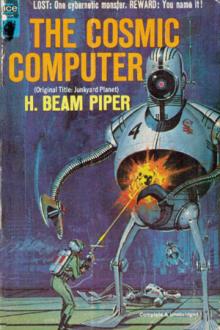The Cosmic Computer - H. Beam Piper (best black authors txt) 📗

- Author: H. Beam Piper
Book online «The Cosmic Computer - H. Beam Piper (best black authors txt) 📗». Author H. Beam Piper
The only trouble, after they found it, was that it was completely dead. The reactors wouldn’t react, the converters wouldn’t convert, and no matter how many switches they shoved in, there was no power output. The inside telemetered equipment, of course, was self-powered. Some of them were dead, too, but from those which still worked Mohammed Matsui got a uniformly disheartening story.
“You know what happened?” he said. “When this gang bugged out, back in 854, they left the power on. Now the conversion mass is all gone, and the plutonium’s all spent. We’ll have to find more plutonium, and tear this whole thing down and refuel it, and repack the mass-conversion chambers—provided nothing’s eaten holes in itself after the mass inside was all converted.”
“How long will it take?” Conn asked.
“If we can find plutonium, and if we can find robots to do the work inside, and if there’s been no structural damage, and if we keep at it—a couple of days.”
“All right; let’s get at it. I don’t know where we’ll find shipyards like these anywhere else, and if we do, things’ll probably be as bad there. We came here to fix things up and start them, didn’t we?”
XIVIt didn’t take as long as Mohammed Matsui expected. They found the fissionables magazine, and in it plenty of plutonium, each subcritical slug in a five-hundred-pound collapsium canister. There were repair-robots, and they only had to replace the cartridges in the power units of three of them. They sent them inside the collapsium-shielded death-to-people area—transmitter robots, to relay what the others picked up through receptors wire-connected with the outside; foremen-robots, globes a yard in diameter covered with horns and spikes like old-fashioned ocean-navy mines; worker-robots, in a variety of shapes, but mostly looking like many-clawed crabs.
Neither the converter nor the reactor had sustained any damage while the fissionables were burning out. So the robots began tearing out reactor-elements, and removing plutonium slugs no longer capable of sustaining chain reaction but still dangerously radioactive. Nuclear reactors had become simpler and easier to service since the First Day of the Year Zero, when Enrico Fermi put the first one into operation, but the principles remained the same. Work was less backbreaking and muscle-straining, but it called for intense concentration on screens and meters and buttons that was no less exhausting.
The air around them began to grow foul. Finally, the air-analyzer squawked and flashed red lights to signal that the oxygen had dropped below the safety margin. They had no mobile fan equipment, or time to hunt any; they put on their fishbowl helmets and went back to work. After twelve hours, with a few short breaks, they had the reactors going. Jerry Rivas and a couple of others took a heavy-duty lifter and went looking for conversion mass; they brought back a couple of tons of scrap-iron and fed it to the converters. A few seconds after it was in, the pilot lights began coming on all over the panels. They took two more hours to get the oxygen-separator and the ventilator fans going, and for good measure they started the water pumps and the heating system. Then they all went outside to the ship to sleep. The sun was just coming up.
It was sunset when they rose and returned to the building. The airlocks opened at a touch on the operating handles. Inside, the air was fresh and sweet, the temperature was a pleasantly uniform 75 degrees Fahrenheit, the fans were humming softly, and there was running hot and cold water everywhere.
Jerry Rivas, Anse Dawes, and the three tramp freighter fo’c’sle hands took lifters and equipment and went off foraging. The rest of them went to the communications center to get the telecast station, the radio beacon, and the inside-screen system into operation. There were a good many things that had to be turned on manually, and more things that had been left on, forty years ago, and now had to be repowered or replaced. They worked at it most of the night; before morning, almost everything was working, and they were sending a signal across twenty-eight million miles to Storisende, on Poictesme.
It was late evening, Storisende time, but Rodney Maxwell, who must have been camping beside his own screen, came on at once, which is to say five and a half minutes later.
“Well, I see you got in somewhere. Where are you, and how is everything?”
Then he picked up a cigar out of an ashtray in front of him and lit it, waiting.
“Port Carpenter; we’re in the main administration building,” Conn told him. He talked for a while about what they had found and done since their arrival. “Have you an extra viewscreen, fitted for recording?” he asked.
Five and a half minutes later, his father nodded. “Yes, right here.” He leaned forward and away from the communication screen in front of him. “I have it on.” He gave the wavelength combination. “Ready to receive.”
“This is about all we have, now. Views we took coming in, from the ship and a scout-boat.” He started transmitting them. “We haven’t sent in any claims yet. I wasn’t sure whether I should make them for Alpha-Interplanetary, or Litchfield Exploration & Salvage.”
“Don’t bother sending in anything to the Claims Office,” his father said. “Send anything you want to claim in here to me, and I’ll have Sterber, Flynn & Chen-Wong file them. They’ll be made





Comments (0)